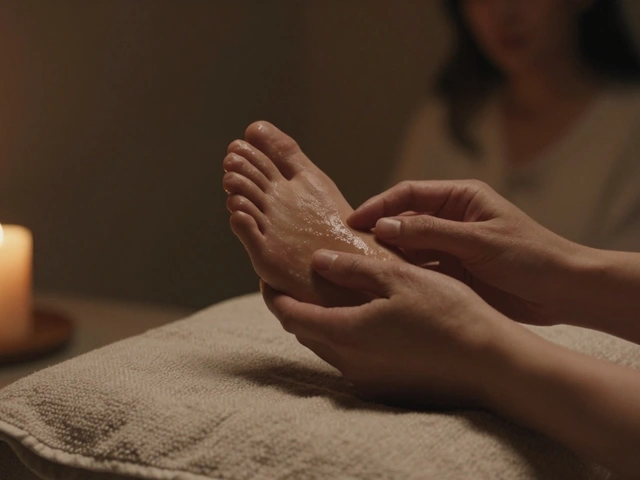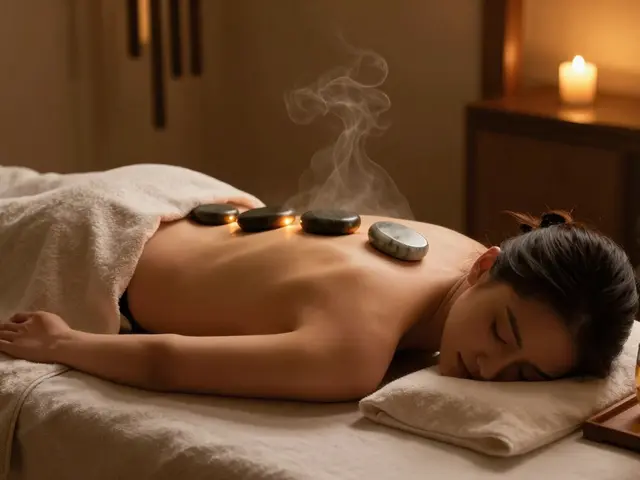My back used to hurt so bad that I’d get cranky playing with the kids. Late nights pacing the kitchen, searching for relief, got me scrolling through wellness forums in hopes of anything less disappointing than that dusty heating pad in the drawer. And that’s when something weird caught my eye: Maya abdominal massage. I’d never heard of it, but the more I read, the more I wanted in. Stories about improved digestion, less period pain, and even help with fertility sounded almost too good to be true—but curiosity got the best of me.
What is Maya Abdominal Massage?
Maya abdominal massage isn’t some trendy new hack. It’s actually based on an ancient tradition that comes straight from the indigenous healers of Central America—especially the Maya people of Belize, Guatemala, and Yucatán. Their belief was simple: most imbalances in the body start with the abdomen, home to your digestion, reproduction, and even your emotional “gut feeling.”
This hands-on technique uses gentle, focused pressure on your abdominal area and lower back. The main goal? Realign internal organs, release physical blockages, and encourage better flow of blood, lymph, and vital energy. It’s a different school from deep-tissue sports massages. Practitioners go in with an open palm, not a clenched fist, searching for areas of tension, congestion, or misplaced organs—yes, that’s a thing, especially if you spend hours slouched at a desk or hunched over your phone. Some practitioners include lower back and hip work since these zones get tight and can affect circulation to your core.
Now, it’s not just about physical technique. There’s a mind-body element here—the Maya believed the abdomen stores deep emotion and stress, which, when left unchecked, can stall healing. When the abdominal massage is done right, it’s not just your belly that feels lighter but your whole outlook. The ritual can involve steam (using aromatic herbs), castor oil packs, and even gentle energy balancing, depending on the practitioner.
What surprised me most was how holistic the whole approach is. You can find Maya abdominal massage in some pretty serious alternative health clinics. It’s a spotlight topic at women’s wellness retreats, fertility circles, and digestive health workshops from L.A. to London. This isn’t just for yoga fans or those deep in the world of alternative medicine; plenty of skeptics are lining up to give it a try after hearing first-hand stories about lasting relief from pain or chronic digestive issues.
Surprising Benefits: Physical & Emotional Healing
Most people are drawn to Maya abdominal massage because they want a fix for something stubborn in their body. For me, it started as a glaring pain in the lower back, but it wasn’t long before I started hearing about benefits that reach far beyond a single ache or cramp.
Let’s kick off with the gravity of abdominal organ alignment. Modern life—think chairs, tight jeans, and endless screens—can mess with your natural gut position. The uterus, bladder, intestines, and stomach can shift, get squished, or develop tightness in the surrounding fascia. Maya massage aims to gently coax these organs back into proper alignment. Anecdotal reports and small-scale studies hint at a noticeable reduction in chronic bloating, IBS symptoms, and period pain. Some women report lighter, shorter, or more regular cycles after a few sessions, while others chasing answers for stubborn fertility issues say they finally found hope here—especially when Western medicine offered little explanation beyond “unexplained infertility.”
The magic of Maya abdominal massage doesn’t stop at the digestive tract. Blood flow is a recurring theme. By moving sluggish lymph and encouraging more blood to sensitive tissue, you’re essentially reminding your organs to do their jobs better. Good circulation is key for hormone balance and cell repair. One 2018 study out of Guatemala tracked more than 200 women with menstrual discomfort over a year, finding that those receiving regular Maya abdominal massages reported fewer headaches, lighter periods, and less painkiller use. On the men’s side, one less-discussed application is prostate health: proper massage encourages healthy tissue and circulation, which can mean fewer future troubles.
Emotionally, it’s a bit of a game-changer. The abdomen is sometimes called “the second brain” for a reason. Some practitioners point to links between releasing emotional blockages—grief trapped after a loss, anger you never processed, anxiety that churns in your gut—and feeling lighter in spirit. Several clients swear by the emotional catharsis after a good session, and it’s not rare to hear about tears or laughter bubbling up while on the table. After my third massage, I remember walking home and noticing the knot in my stomach was just…gone. I felt less anxious, lighter somehow. It wasn’t just about pain relief; something else had shifted inside me.
Digestive relief is the most obvious win. If you’re someone who knows all too well the daily struggle with bloating or constipation, this technique might be worth trying. The abdominal pumping action encourages peristalsis (that’s the wavelike movement pushing food through your digestive tract), according to 2021 research from Mexico’s National Institute of Medical Sciences. They showed that a series of four weekly Maya massages led to self-reported improvements in regularity, gas, and stomach discomfort in nearly 80% of participants.
Even if you’re skeptical, it’s tough to argue with the bonus of stress reduction. Regular sessions act like a reset button. You’re forced to breathe, slow down, and drop into your body. My wife calls it her “monthly reboot,” and let’s be honest—when we’re more relaxed, our immune system, sleep, and even patience with our kids get a boost.

What to Expect During a Session
Walking into a Maya abdominal massage, leave whatever you think a “massage” feels like at the door. No pounding elbows or awkward spa chatter. Friends warned me: this massage is gentle, but deeply personal.
The session usually starts with a sit-down chat. The therapist will ask you questions about your medical history, lifestyle, digestion, periods (if you’re a woman), surgeries, or trauma—anything that could be relevant to your belly story. They’ll explain how the session works and check your comfort levels. Don’t be surprised if they go through your diet, water intake, sleep patterns, and even emotional stressors. This holistic detective work helps them tailor the treatment and keeps surprises to a minimum.
Once you’re on the table, expect to lie on your back, often in a slightly reclined position, knees bent for comfort. The therapist will place a sheet over you, keeping everything modest, with just the belly and sometimes lower ribs and pelvis exposed. They start with dry hands, gently scanning for tension or temperature differences. The actual massage is slow, rhythmic, and deeper than you’d expect from such soft pressure. You’ll feel circles around your navel, gentle upward and downward sweeps, occasional rocking, and maybe some focus on the lower back or hips. The idea isn’t to knead you into submission, but to coax and teach your organs where to go.
Table practitioners often use warm oils (like castor oil), known for their anti-inflammatory effects. If you’re lucky, you’ll get a steamy towel or aromatic herbs. Some combine gentle manipulations with breathing cues—being told to inhale deeply as the therapist’s hand slides along your belly, syncing up your body and breath. This is where the true magic settles in; your nervous system drops into its “rest and digest” state. Most people feel deeply relaxed, sometimes even emotional, a sign of stuck stress letting go.
The session wraps with self-care tips. My therapist showed me how to do a few simple moves at home for maintenance—think of it as a homework assignment for your gut. Don’t be shocked if you’re a bit sore the next day or if you find yourself running to the bathroom—both are normal. After two or three sessions, you’re likely to notice a change: lighter digestion, better energy, a calmer mind.
- Wear comfy, loose clothes—nothing tight on your waist after your session.
- Don’t eat a big meal right before your appointment.
- Drink water before and after—hydration helps move out toxins.
- If you get nervous talking about your medical history, jot down notes or questions in advance.
Sessions last anywhere from 45 to 90 minutes. Some people go weekly, others monthly. If you want to start, try committing to three consecutive treatments spaced a week apart; that’s when most folks feel real traction. Here’s a scoop from someone with two kids and a busy job: if you can swing it, booking one around your period or after a stressful week is a game changer.
Who Can Benefit and When to Avoid It
This isn’t just a remedy for granola-eating wellness buffs or yoga teachers. The truth is, anyone living in their body can stand to gain a little relief from abdominal massage. Here’s a breakdown of who gets the most from it, and who should steer clear.
- People with digestive issues: Think chronic constipation, IBS, heartburn, or sluggish digestion. Maya massage helps move the process along and can reduce symptoms that leave you doubled over in discomfort.
- Women with gynecological concerns: Irregular periods, cramps, fibroids, endometriosis, or struggles with conception. There’s no magic bullet, but many find their cycles are smoother, lighter, and more predictable after a few sessions.
- Men dealing with pelvic pain or prostate congestion: Gentle abdominal massage improves circulation and can ease leftover tension after prostate procedures or while managing chronic pelvic pain syndromes.
- Those dealing with pain or scar tissue after surgery: By softening adhesions and encouraging alignment, this massage is a healing partner after C-sections, hernia repairs, or abdominal surgeries (after you’re fully healed, of course!).
- People holding stress or trauma in their belly: Anxiety, grief, or past trauma often settle in this area. Maya abdominal massage can gently help process and release what’s stuck emotionally.
There are times to keep away. If you’re pregnant (especially the first trimester), have an active infection, a hernia, or major abdominal inflammation, skip the massage. It’s also a no-go during active menstruation, right after surgery, or if you have certain cancers or clotting disorders—always check with your doctor. Kids and teens can benefit, too, especially if they deal with tummy troubles or cycle pain, but make sure the therapist is familiar with treating younger bodies (my daughter Juliet swears by the gentler version for cramps, while Kurt sometimes requests “the light belly circles” before tests at school).

Myths, Science, and How to Get the Best Results
There’s a lot of confusion—and a sprinkle of mysticism—around Maya abdominal massage. Some skeptics eye-roll about “moving organs” or “energy blocks.” I get it. It sounds out there. But here’s the thing: the benefits aren’t all about magic. Much like how physical therapy uses guided hands to help muscles and joints recover, Maya massage works with the body’s own innate ability to rebalance.
Maya abdominal massage isn’t going to fix everything in a single session. But peer-reviewed studies are slowly stacking up, showing positive effects for digestive regularity, cycle improvement, and even reduced pelvic pain. Harvard Health published a review last year noting that abdominal-focused massage lowers inflammation markers and improves gut motility in people with chronic constipation. That’s data, not daydreaming. Skeptics might still pooh-pooh, but there’s enough evidence to warrant giving it a real try—especially if other paths haven’t worked for you.
The biggest myth? That this massage is just “woo-woo.” Real talk: Traditional Maya healers knew about fascia, internal positioning, and trauma before science put names to it. We now know that nerves running through the abdomen impact hormone production, metabolism, and even emotional states, so keeping that area happy has broad knock-on effects.
Want to get the most out of it? Here are some tried-and-true tips:
- Pick a properly trained therapist. Ask for credentials. Certified Maya abdominal massage (often called Arvigo Techniques of Maya Abdominal Therapy®) practitioners are your best bet.
- Be open-minded, but communicate. Let your practitioner know what you’re comfortable with, what you want to focus on, and what your biggest complaints are—no need to hold back.
- Commit to follow-up care. Doing your home moves between sessions keeps the magic alive.
- Journal what changes you feel. Sometimes improvements are so gradual (better sleep, less tension, less bloating) that you’ll forget you ever ached to begin with.
- Hydrate and rest post-session. Your body’s working behind the scenes even after you leave the table.
And if you like stats, here are some findings you’ll appreciate:
| Condition | Improvement Rate | Study Year |
|---|---|---|
| Digestive Issues (includes IBS) | 79% | 2021 |
| Menstrual Difficulties | 70% | 2018 |
| Chronic Lower Back Pain | 64% | 2020 |
| Emotional Well-being | 82% | 2019 |
I realize some things you just have to experience for yourself. For my family, it’s been one of those small but mighty changes that keeps popping up in our group chats and dinner table conversations. If you’ve got a stubborn pain, a tummy that never quite settles, or just want to feel more grounded and “at home” in your body, maybe it’s time to try what the Maya have known for centuries. And who knows? It might be the missing piece you didn’t even know you were searching for.










